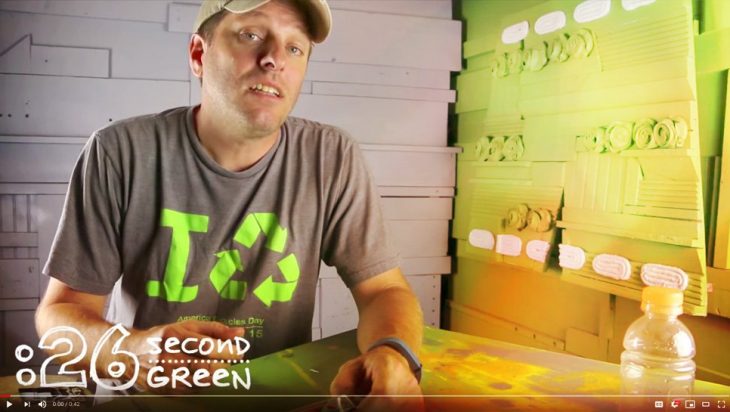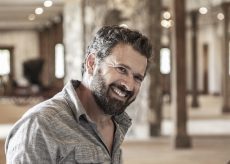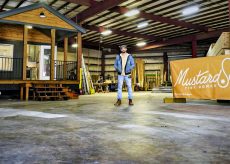‘How-To’ video creator Tom Mills makes world greener :26 at a time

If you want to learn how to make a rain barrel, construct a worm tower or set up a composter, you should be prepared to sit in front of your preferred YouTube delivery device for a while. Many of the topics associated with sustainability can be complex enough to warrant videos longer than your average peek at playful kitten antics.
That’s too bad, says Tom Mills, founder of Greenshortz. He believes the length of videos that run 15 minutes, 30 minutes or more have a strong role to play in helping educate people, but he also sees merit in publishing content that is shorter and can be more easily consumed during a quick visit to a site on a phone.
His answer? Greenshortz, a YouTube channel that includes a series of videos conceived, shot and edited to run on average no more than 26 seconds. He may not be able to explain the nuances of connecting a solar panel to your roof in that duration, but he can cover, say, how to buy green toilet paper, recycle in a parking lot or how to get paid for the aluminum cans you pick up on your walks.
Less is more, as they say.
Proud Green Home recently spoke with Mills about the advantages for the planet and his audience of keeping things short, sweet and simple.
Proud Green Home: What is the goal with these “26 Second Greens,” as you call them, and who is your target audience?
Tom Mills: I think my goal is to gather people outside of our typical sustainability circles—just at the periphery—that might be interested in sustainability and engaging them in the simplest way. That’s why I make the videos so short—the “26 Second Green”—because I feel like in that amount of time I can get them enough information to let them decide whether they’re interested or not, at least in that particular element. A sort of single-message moment.
PGH: How and when did this get started?
TM: For me, it began even before I started making these videos back in 2008. I had been in an engineering firm for about eight years, doing marketing and video-creation projects. We did a lot of water treatment, waste-water plants, stormwater management stuff, so that’s really when I started making videos about that.
Initially, when I left that company to start my own business and put out my own content, I thought I’d just start with some DIY videos to sell on DVD. I was thinking I could call them “Ecoshortz.”
But then I read a study by OgilvyEarth on the Chinese and American consumption economy. It stated something like 80-82 percent of Americans have good intentions of being green, but only 16 percent do anything about it. So, to me, that 66 percent in the middle represented a huge audience of people who wanted to live more green—to be more sustainable—but they didn’t quite know how to do it. And there were just so many different factors that contributed to the perception that “green” was unobtainable, was expensive, that it was for the wealthy, or that it was for people who are sort of what are pejoratively called “granolas” who always do things like that.
Also, there was also this enormity of options for going green, and that in itself was overwhelming for people. The words I remember from the study were that it just led to this “retreat to ignorance” —that a lot of the time people would rather just check out and do nothing.
I quickly realized that there were so many more opportunities to educate than just sharing DIY content. I could show stuff where they didn’t necessarily have to make anything, just change a habit. So I decided to call them GreenShortz because of the tag line, which at the time was, “Put your green on one leg at a time.” The idea was that incremental change is far better than trying to do it all at once and to end up not doing anything.
PGH: Why 26 seconds, specifically?
TM: Well, I knew I wanted the videos to be super short, and honestly, I wanted them under 30 seconds because, at the time, that was Instagram’s video limit, but I picked 26 because of the alliteration. Twenty-six seconds. They all end with the phrase, “26 Second Green: You got time for this.” The idea is that the audience has time to both watch it and perhaps to integrate that into their lives.
PGH: Where do you get the info for the videos?
TM: Typically I just start from my own experience and then I’ll go and find 1-2 data points just to back up that experience—just enough that I’m not going to be comprehensive, because there’s not going to be enough time, but can still give them one thing that backs up what I’m saying and will hopefully pique their interest into Googling more or reading more or just doing it.
There are really so many creative and maybe a little nutty ways to come up with new approaches to doing things that are more environmentally friendly. Honestly, I think the person I’ve changed the most on this journey is myself. There are new habits I’ve formed that I can’t not do now. Like I can’t throw paper towels away anymore. I have to throw them in the composter.
There’s so much waste in buildings that’s paper towels. Now, when I go somewhere with a client, or to an airport, or wherever, when I use a paper towel, I put it in my pocket and I bring it home. I have a vermicomposter where the worms can use it as bedding. Paper can be recycled up to seven times, but at that stage, the fibers are just too short to be reused and that’s the end of its life, so instead of sending it to the landfill, I return it to the soil. Even on vacation, I keep my compost in a bag in the freezer and then I bring it home.
PGH: A lot of the information in your videos, especially with the more detailed DIY projects, is based on fairly complex biological or engineering concepts. Are you an engineer by trade or just a very experienced tinkerer?
TM: I would say I’m a maker. My dad was an engineer and had a woodshop that I messed around in growing up. I took shop class, got used to using tools, and then I worked at an engineering firm for eight years. So I’m not an engineer by training, but I’d say I have an engineering mind. My dad would say I’m far more creative than he is. I guess I’m sort of a blend of intuitive, creative and engineer. Tinkerer might fit in some cases, but for the most part, I’d call myself a maker rather than a tinkerer.

PGH: What’s next for GreenShortz? How about the Mills family? I hear you’re gearing up to design and build your own “net zero home.” What can you tell me about that?
TM: Yes, well that dream grew out of my incremental green content. Owning a green home became important because I saw all of the inefficiencies of the old house I lived in, but I also wanted to educate people about what made a home “green.” I feel like there’s a lot of misconceptions out there. It’s actually not “net zero.” Net zero is very expensive. I’m not generating any power, it’s just all about efficiencies. I am pre-wired for solar and I do capture rainwater, but for the most part, it’s all just about efficiencies. I feel like there’s a lot of low-hanging fruit when you build a house. You can build in some efficiencies that most builders are not going to, because they require detail and work, and builders are trying to build houses as fast as possible. They’ll cut corners. For example, they’ll often oversize an AC unit to make a house feel comfortable because it’s so leaky. They have to do that, but that’s probably another conversation. We did get LEED certified and EarthCraft Gold. We probably should’ve gotten Platinum, but we didn’t get a few things verified for various reasons that we should have, and I’m happy with Gold.
Curious about how you can make your life more green? Check out one of Tom’s “26-Second Greens” on how to recycle small bits of plastic below, or visit the Greenshortz YouTube channel for any of his other 200-plus educational and DIY videos



